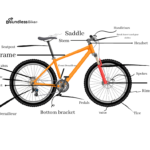Are you an avid cyclist looking to upgrade your road bike handlebars? Or perhaps you’re just curious about why road bike handlebars are curved in the first place. Whatever your reason for stumbling upon this article, we’ve got you covered! In this post, we’ll dive into the reasons behind the design of curved road bike handlebars and explore their benefits. Plus, we’ll provide some tips on how to choose the right set of handlebars for your cycling needs. So hop on and let’s take a ride through the world of curved road bike handlebars!
Why Are Road Bike Handlebars Curved?

The design of road bike handlebars has come a long way since the early days of cycling. In fact, the curved shape that we see on most modern road bikes was not always the norm. So why are road bike handlebars curved in the first place?
One reason for the curvature is to provide riders with multiple hand positions while they ride. This allows them to change their grip and posture as needed, reducing fatigue and improving overall comfort during long rides.
Another benefit of curved handlebars is improved aerodynamics. When cyclists ride in a more aggressive position, with their hands resting on the lower portion of the bars, they can reduce wind resistance and increase their speed.
Of course, different types of road bike handlebars have varying degrees of curvature and can offer different benefits depending on your riding style and preferences. That’s where choosing the right set becomes important!
The Different Types of Road Bike Handlebars
Road bike handlebars come in different shapes, sizes, and types. Each type of road bike handlebar serves a specific purpose and offers unique benefits to the rider. Here are some of the most common types of road bike handlebars.
1) Drop Bars: These are the most popular handlebar style among road cyclists. They offer multiple hand positions for comfort during long rides and provide an aerodynamic position when riding against strong winds.
2) Flat Bars: This type of bar is similar to those found on mountain bikes but with a more narrow design. Flat bars work best for riders who prefer an upright position while cycling.
3) Bullhorn Bars: These bars are commonly used by triathletes and time trialists due to their aerodynamic design that offers multiple hand positions for better control over the bike.
4) Aero Bars: Also known as “tri-bars,” these bars attach to drop bars or bullhorns and allow riders to assume a forward-leaning position that reduces wind resistance during time trials or triathlons.
It’s important to choose the right type of road bike handlebar based on your cycling goals, preferences, body measurements, and riding style. Always seek professional guidance from experienced cyclists or a local bicycle shop before making any changes to your current setup.
How to Choose the Right Road Bike Handlebars for You
When it comes to choosing the right road bike handlebars for you, there are a few factors that you should consider. First and foremost is your riding style and preferences.
If you prefer a more aggressive riding position, then drop handlebars may be the way to go. This type of handlebar allows for multiple hand positions and provides good aerodynamics when riding at high speeds.
On the other hand, if comfort is your top priority, then flat or riser handlebars may be a better choice. These types of bars provide a more upright riding position which can reduce strain on your back and neck.
Another important factor to consider is bar width. Generally speaking, wider bars provide more stability but can also make steering feel less responsive. Narrower bars offer sharper handling but can feel twitchy at high speeds.
Don’t forget about materials and construction quality when considering new handlebars. Higher-end carbon fiber options will typically be lighter weight with greater strength than aluminum or steel alternatives.
Choosing the right road bike handlebars ultimately comes down to personal preference based on your individual riding style and needs.
Factors to Consider When Choosing Curved Road Bike Handlebars
When choosing curved road bike handlebars, there are a few key factors that you should consider to ensure the best fit and performance. The first factor is the shape and size of the curve itself. Different types of curves will affect your hand placement and overall comfort on the bike.
Another important consideration is the width of the handlebars. A wider bar can provide more stability and control, while a narrower bar may be better for aerodynamics and speed. It’s also essential to choose handlebars that match your riding style, whether it be long distance touring or fast-paced racing.
The material of your curved road bike handlebars is another crucial factor. Carbon bars are lightweight but may not be as durable as aluminum options, which can withstand more wear-and-tear over time.
Don’t forget about ergonomics when selecting curved road bike handlebars. Make sure they fit comfortably in your hands without causing any strain or discomfort during extended rides.
Taking these factors into account when choosing curved road bike handlebars can help you find an option that fits both your body type and riding needs for optimal performance on every ride!
Benefits of Curved Road Bike Handlebars
Curved road bike handlebars have several benefits that make them a popular choice among cyclists.
- The first and most obvious benefit is the improved aerodynamics they offer. When you’re riding with your hands resting on the curved part of the bars, your body becomes more streamlined, reducing wind resistance and allowing you to ride faster.
- Another advantage of curved handlebars is that they provide multiple hand positions for comfort during long rides. You can grip the top of the curve for better control when climbing steep hills or sprinting at high speeds. Alternatively, you can rest your hands on the brake hoods for a relaxed position during endurance rides.
- Curved handlebars also allow riders to adjust their posture easily, which helps prevent fatigue and discomfort in their shoulders, neck, and lower back muscles. With different hand positions available at any given moment along a ride’s duration, riders won’t be stuck in one uncomfortable position all throughout.
- Using curved road bike handlebars allows cyclists to corner with more precision while maintaining stability over uneven terrain. This enables them to remain confident even as they navigate twisty descents or tight turns.
- Curved road bike handlebars improve aerodynamics while offering multiple comfortable hand positions that give added versatility to cycling enthusiasts’ training routine – all resulting in an enhanced level of performance when it matters most!
Conclusion
After exploring the reasons behind why road bike handlebars are curved and discussing the different types of handlebars available, it’s clear that there is no one-size-fits-all answer when it comes to choosing the right type of handlebar for your needs.
When selecting a curved road bike handlebar, factors such as riding style, body dimensions, and intended use should all be taken into account. It’s important to consider what feels comfortable for you while also keeping in mind any potential benefits or drawbacks of each option.
Ultimately, the decision on which curved road bike handlebar to choose will depend on personal preference and individual needs. A professional fitting session with a trained expert can help ensure that your chosen handlebar provides optimal comfort and performance.
Whether you prefer drop bars or compact bars or something in between, understanding the factors involved in selecting a curved road bike handlebar can help you make an informed decision about what works best for your unique cycling goals. So go ahead and hit those curves with confidence!






